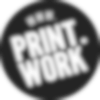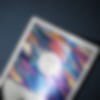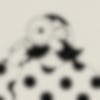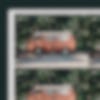The world of printing can be confusing for a newcomer, so we’ve put together a handy glossary of all the printing terms you need to know to get to grips with the in’s-and-out’s. If you can’t find the definition you’re looking for, feel free to drop our team a message via our live chat or email hello@print.work
A
- Ai file – A file readable by Adobe Illustrator, a popular design software. Shapes and lines created in an Ai format are made of vectors rather than pixels. However, Ai files can accommodate pixel based images when necessary. They are also able to include multiple layers.
B
- Bespoke orders – These are orders that have more unique specifications and require customised pricing.
- Bleed / Bleed Area – The bleed area refers to the area at the edge of the canvas that is likely to be cut during the trimming process. The industry standard for this area is 3mm, which is why we require all files to be supplied with a 3mm bleed, meaning all sides of the design should be expanded outwards by 3mm. For example, this would increase file measurements for an A4 print from 297x210mm to 303x216mm. For a more detailed explanation of bleed, check out our handy guide here.
- Border – A (usually white) area surrounding an image, preventing it from reaching the edge of the paper. The smallest border we can print is 5mm. Not to be confused with bleed (above).
- Bulk pricing – A pricing model that ensures the price per unit becomes more cost effective as the quantity of the item’s orders increases.
C
- C-Fold – The most common method of a tri-fold leaflet, a C-fold uses two parallel folds to create 6 panels (3 on each side) that fold towards each other so that they overlap.
- CMYK – A colour mode (see below) consisting of Cyan, Magenta, Yellow, and Key (black). This colour mode is the standard for print. Files created in this mode may look duller than their RGB counterparts, but they offer a more accurate depiction of the final print.
- Colour modes/spaces – A palette of individual colours that when combined can create a large range of hues. If you design in a certain colour mode, you won’t be able to use colours from outside that mode. The most common modes are CMYK and RGB. For more information on colour modes, take a look at our helpful guide here.
- Crop marks – Guides on a print ready file that indicate where the file will be trimmed down.
- Cut lines – Primarily used for files that will be cut using our die cutting machine, cut lines are magenta lines (not shapes) that guide where the blade will trim. We require cut lines on files that are to be custom cut.
- Custom shaped stickers – Individually cut and supplied stickers that are cut into a custom shape using our die cutting machine, available on our website here.
D
- Die cut – A method of cutting down prints to an unusual shape or size. Die cuts go all the way through the paper, as opposed to a kiss cut (see below).
- Digital printing – A method of printing that transfers imagery from a digital-based image onto the desired media.
- DPI – Dots Per Inch is a way of measuring image resolution. Digital printers use tiny dots of ink to make up an image. The more dots, the more detail in the print. We ask that files are 300dpi to ensure a high quality finish. DPI is sometimes used interchangeably with PPI (see PPI definition below).
E
- Embed – Implanting a linked image/text within a file, allowing it to be viewed by another user when opening the file on a different computer. Images that are not embedded within the file risk not appearing when opened on another device.
F
- File types – Different formats in which your designs can be exported as and supplied to us, such as PDF, JPEG, or PNG.
- Finished page size – the size that your final prints will be cut down to.
- Font – A specific style, weight, and size of a typeface (see below). Font and typeface are often used interchangeably, and the difference between them is subtle.
- Full bleed – The artwork extends fully to the edge of the canvas.
- Full colour designs – designs containing large areas of bright colours.
G
- Grayscale – A colour mode containing only different shades of the colour Grey. Images in this mode appear black and white, rather than full colour.
- GSM – Grams per Square Metre. While technically a measurement of weight, gsm is often used as an indicator of paper thickness. The higher the number, the heavier the paper.
H
- Heavy ink coverage – Designs with large areas of colour (such as a design with a black background) will have a lot of ink coverage, which can cause some print to appear shiny depending on the stock and colour.
J
- JPEG/JPG – A file format mainly used for digital images and photographs. JPEGs use lossy compression, meaning they sacrifice some quality in order to keep the size of the file low. They can be made in several colour modes, but do not include layers. The format is named after its creator, the Joint Photographic Experts Group.
K
- K value – The amount of black in a CMYK colour, measured in percentage along with the other 3 colours. 100% K is pure black.
- Kiss cut – A cut that does not go all the way through the paper. This is often used to create peelable sticker sheets.
M
- MOQ – Minimum order quantity.
- Multiple artworks – A feature of our website that allows you to print multiple designs using the same line item, making your order more cost effective.
O
- Orientation – How a design is positioned, such as portrait or landscape.
- Outline fonts – A way of converting fonts into lines, meaning they can be viewed on devices that don’t have the specific typeface installed. Outlining fonts is usually done by using the ‘create outlines’ option in Adobe software.
P
- Packaged file – A folder containing all the linked images, typefaces and the design file for a project. Sending a packaged file ensures the receiver has everything they need to view and edit the file. They can be created automatically using the ‘package’ option in Adobe software.
- PDF – A file format capable of presenting images, text, vector graphics and more in a single document. No matter the hardware or software, a PDF will always appear the same. Saving artwork as a PDF is a good way to maintain the quality, particularly when working with vector graphics. It stands for Portable Document Format.
- PNG – A file format designed for sending images over the internet. The format does not support the CMYK colour mode, and is therefore unsuitable for print. It’s main advantages are transparency, and lossless compression. It stands for Portable Network Graphics.
- Pp (printed pages) – Usually used in reference to booklets and multiple page prints, this refers to the number of pages containing printed material.
- PPI – Pixels Per Inch is a way of measuring the resolution of a digital file. The higher the PPI, the higher the quality. PPI is sometimes used interchangeably with DPI.
- Print preview – the option when uploading files to our website that allows you to see a preview of how your designs will look when printed.
- PSD file – A PhotoShop Document. These files support all the Photoshop features including layers, masks and transparency. Despite the name, they can be created using other software such as Procreate.
- Proof – A copy of the print ready file that can be sent to you for you to approve before the order is moved into production. This allows you to request any amendments or highlight any issues before the order is printed.
R
- Rasterize – To turn a vector image into a pixel based image. Images created in vector based software such as Illustrator will often need to be rasterized before they can be edited in pixel based software such as Photoshop.
- Registration black – A way of creating black by using 100% coverage from all the CMYK inks. It is commonly used to check the registration of a printer and can cause problems in large volumes due to the amount of ink being used.
- Resolution – This is effectively the quality of an image. The higher the resolution, the better the image quality. Resolution is measured in PPI or DPI, meaning pixels / dots per inch. The more pixels per inch, the better. For further information on resolution and how it affects files, take a look at out guide here.
- Rich black – A black colour created from 60% Cyan, 40% Magenta, 40% Yellow and 100% Black (K) ink. As the name suggests, it results in a rich, deep black tone.
- Risograph printing – A method of printing that creates prints layer by layer using a stencil that wraps around the drum.
- RGB – A colour mode consisting of Red, Green, and Blue. This colour mode is the standard for electronic devices, using light to create bright hues that cannot be replicated in printed ink. We do not print in RGB.
S
- Saddle stitch – A method of binding in which staples on the spine of a booklet are used to keep the pages together. Despite the name, no stitching is involved.
- Safe area – The space within a design that will not be affected by trimming.
- Sample pack – A free pack containing samples of our paper range, available here.
- Sample print – Test prints of your designs that allow you to try out our stocks and see if any amendments need to be made to your designs before committing to a full print run, available to order here.
- Scanner – A scanner is a piece of kit that converts physical artworks into digital images, often at a high quality. While some mobile apps try to replicate this process, only a dedicated scanner can create truly accurate results.
- Send artwork later – an option available when placing an order that allows you to submit your files via email or wetransfer at a later date. Orders cannot progress until the artwork has been received.
- Staple bound – An alternative name for ‘saddle stitch’ binding (see above).
- Sticker sheets – An A5 or A6 sheet with multiple custom shaped sticker designs that can be peeled away from the sheet, available to purchase here.
- Spot colour – A pre-mixed ink used instead of CMYK, effectively bypassing the mixing process. They are usually used to print colours that can’t be created in CMYK, such as fluorescent hues and white.
T
- Tolerance – The amount of leeway we allow when cutting down prints to size. Our tolerance is 1.5mm either way.
- Typeface – A collective term for a set of fonts that share a common design. For example, Times New Roman is a typeface which contains the fonts Times New Roman Bold, and Times New Roman Italic (among others). However, the terms typeface and font are often used interchangeably.
V
- Vector – A type of graphic that uses geometric shapes rather than pixels to create an image. They can be scaled indefinitely without losing quality, and are commonly used for diagrams and typography.
- Vectorise – The process of converting a pixel based image into a vector based one.
U
- Uncoated – If a paper is uncoated, this means that it is more porous and the finished print will appear more textured.
W
- WeTransfer – WeTransfer is a popular in-browser file sharing service. It’s free to use and can transfer files that are too big to send by email. Other similar programmes include Google Drive and Dropbox.
Z
- Z-fold – A zig-zag type fold applied to Tri-Fold prints. From above, a Z-fold resembles the shape of a Z.



